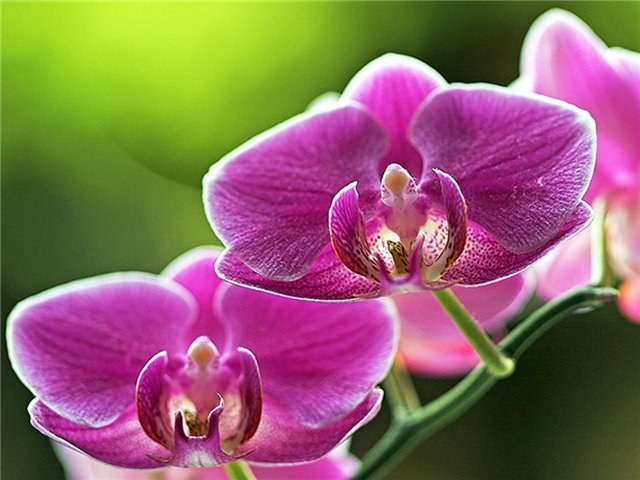Proper lighting and temperature
Proper lighting is a key factor in caring for orchids, it determines whether your plant to bloom. The lack of light room pet is not enough power for the normal vegetation cycle, when excessively intense light flower burn.
Orchid feels great in the afternoon when the temperature 18-27 degrees, at night – from 13 to 24 degrees. A necessary condition for the flowering of orchids is the difference in day and night temperatures. If the room is heated centrally, you should try to make the plant more cool nights. Transfer pot at night in cooler conditions helps as distillation, in a short time the plant produces new stems. Most orchids have the ability to withstand moderate deflection temperature. When the temperature of air is necessary to reduce watering, increase – to increase.
Watering and humidity
Orchids in nature are not in the water. Their roots do not tolerate waterlogging, exposure to salts in the water. The intensity of irrigation is influenced by humidity and temperature, the phase of the seasonal vegetation, the size of the pot, the intensity of illumination. Orchids are tolerant of dry soil than to waterlogging. Therefore, the substrate must have time to dry out between waterings. The lack of humidity, the plant will react withered and crumpled leaves, moisture – sodden and yellowed leaves, rotten roots.
Reinforced Orchid requires watering only during the release of the peduncle, flowering and in active growth phase. Put the pot in a container of warm water for ten minutes pour or plant intensively from the soul, that the soil has had time to completely dry, as excess moisture out of the drainage holes. In both cases, the orchids need to hold the grill so all the excess water drained, only then, the pot can be put in its place.
The optimum humidity should be 60-80%. If you have a house dry air, then you can use pallets with slatted bottom, filling to the bottom of the water, placing on top of the drainage layer of pebbles or gravel. The roots of the plants and bottom of the container should not touch the water. In hot weather the flower is recommended to spray warm water from a spray bottle.
Transplanting and fertilizing
Grew beyond the boundaries of the pot green part of the plant serves as a signal that the flower required a transplant. To perform this manipulation is necessary only once the Orchid is out of bloom, a little rest (that is, at the beginning of a new period of growth). Carefully remove the plant from the pot, be careful not to damage the roots, remove almost all the old soil, cut with scissors rotten or dead roots.
The pot should be two inches larger in diameter the previous capacity. Lay the bottom layer of expanded clay, pour a little of the substrate for orchids, carefully place in the pot an Orchid, fill with fresh soil. The substrate must fill the space between the roots of the flower. Lightly press the soil, not too uplotnaet it. The growing point must not be covered with soil. Lightly pour room pet with warm water, put a few days into the shadows.
Orchids need a balanced and regular fertilizing. It is advisable to purchase for these purposes a special fertilizer designed for orchids. Dilute them according to the instructions. Reduce feeding during the cold season and the dormant period.
